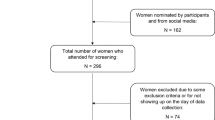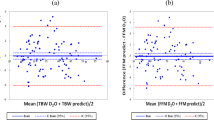Abstract
Background/Objectives:
Bioelectrical impedance analysis (BIA) is one of the most affordable and feasible body composition assessment techniques for clinical and field settings. However, it is important to use an equation appropriate for the study population. This study aimed to propose and validate prediction equations to estimate body composition using BIA for Indonesian men.
Subjects/Methods:
Total body water (TBW), fat-free mass (FFM) and fat mass (FM) were determined using the deuterium dilution technique in 292 Indonesian males. Participants were divided equally into development and validation groups to develop prediction equations and to cross-validate the proposed prediction equations, respectively. In addition, selected prediction equations using BIA were cross-validated.
Results:
The proposed BIA equations were valid in our cross-validation samples. The best performance equations obtained from the absolute measure of body composition (TBW, FFM and FM) showed that r ranged between 0.89 and 0.91 and standard error of the estimate=1.8–2.6 kg. Cross-validation analysis indicated that the proposed equations had a bias of 0.1–0.3 kg, pure error of 1.3–1.8 kg and limits of agreement (mean difference±1.96 s.d.) of −0.26 to 0.13±4.09 to 5.59 kg. Among existing prediction equations examined, those by Deurenberg et al. (1989) and Lukaski et al. (1987) significantly overestimated FM by 4.0 and 3.2 kg, respectively, whereas the equation by Deurenberg et al. (1991) significantly (P<0.001) underestimated FFM by 5.0 kg compared with the reference FFM.
Conclusions:
The new BIA prediction equations may provide more precise and accurate estimation of body composition in Indonesian men than the existing equations.
This is a preview of subscription content, access via your institution
Access options
Subscribe to this journal
Receive 12 print issues and online access
$259.00 per year
only $21.58 per issue
Buy this article
- Purchase on Springer Link
- Instant access to full article PDF
Prices may be subject to local taxes which are calculated during checkout



Similar content being viewed by others
References
Thibault R, Genton L, Pichard C . Body composition: why, when and for who? Clin Nutr 2012; 31: 435–447.
Ministry of Health Republic of Indonesia Riset Kesehatan Dasar Republik Indonesia 2013.
Going S . Hydrodensitometry and air displacement plethysmography. In: Heymsfield SB, Lohman TG, Wang Z, Going SB (eds). Human Body Composition. Human Kinetics: Champaign, IL, USA, 2005, pp 17–34.
Schoeller D . Hydrometry. In: Heymsfield SB, Lohman TG, Wang Z, Going SB (eds). Human Body Composition. Human Kinetics: Champaign, IL, USA, 2005, pp 35–50.
Lohman T, Chen Z . Dual-energy X-ray absoptiometry. In: Heymsfield SB, Lohman TG, Wang Z, Going SB (eds). Human Body Composition. Human Kinetics: Champaign, IL, USA, 2005, pp 63–78.
Ross R, Janssen I . Computed tomography and magnetic resonance imaging. In: Heymsfield SB, Lohman TG, Wang Z, Going SB (eds). Human Body Composition. Human Kinetics: Champaign, IL, USA, 2005, pp 89–108.
Norgan N . Laboratory and field measurements of body composition. Publ Health Nutr 2005; 8: 1108–1122.
Heyward V, Wagner D . Applied Body Composition Assessment. Human Kinetics: Champaign, IL, USA, 2004.
Deurenberg P, Deurenberg-Yap M, Wang J, Lin FP, Schmidt G . Prediction of percentage body fat from anthropometry and bioelectrical impedance in Singaporean and Beijing Chinese. Asia Pac J Clin Nutr 2000; 9: 93–98.
Deurenberg-Yap M, Deurenberg P . Bioelectrical impedance: from theories to applications. Mal J Nutr 2001; 7: 67–74.
Böhm A, Heitmann BL . The use of bioelectrical impedance analysis for body composition in epidemiological studies. Eur J Clin Nutr 2013; 67: S79–S85.
Kyle UG, Bosaeus I, De Lorenzo AD, Deurenberg P, Elia M, Manuel Gomez J et al. Bioelectrical impedance analysis-part II: utilization in clinical practice. Clin Nutr 2004; 23: 1430–1053.
Dehghan M, Merchant AT . Is bioelectrical impedance accurate for use in large epidemiological studies? Nutr J 2008; 7: 26.
Aglago KE, Menchawy IE, Kari KE, Hamdouchi AE, Barkat A, Bengueddour R et al. Development and validation of bioelectrical impedance analysis equations for predicting total body water and fat-free mass in North-African adults. Eur J Clin Nutr 2013; 67: 1081–1086.
Buchholz AC, Bartok C, Schoeller DA . The validity of bioelectrical impedance models in clinical populations. Nutr Clin Pract 2004; 19: 433–446.
Macias N, Aleman-Mateo H, Esparza-Romero J, Valencia ME . Body fat measurement by bioelectrical impedance and air displacement plethysmography: a cross-validation study to design bioelectrical impedance equations in Mexican adults. Nutr J 2007; 6: 18.
Martinoli R, Mohamed EI, Maiolo C, Cianci R, Denoth F, Salvadori S et al. Total body water estimation using bioelectrical impedance: a meta-analysis of the data available in the literature. Acta Diabetol 2003; 40: S203–S206.
Phillips SM, Bandini LG, Compton DV, Naumova EN, Must A . A longitudinal comparison of body composition by total body water and bioelectrical impedance in adolescent girls. J Nutr 2003; 133: 1419–1425.
Sun SS, Chumlea WC, Heymsfield SB, Lukaski HC, Schoeller D, Friedl K et al. Development of bioelectrical impedance analysis prediction equations for body composition with the use of a multicomponent model for use in epidemiologic surveys. Am J Clin Nutr 2003; 77: 331–340.
Chumlea W, Sun S . Bioelectrical impedance analysis. In: Heymsfield S, Lohman T, Wang Z, Going S (eds). Human Body Composition. Human Kinetics: Champaign, IL, USA, 2005, pp 79–88.
Küpper J, Bartz M, Schultink JW, Lukito W, Deurenberg P . Measurements of body fat in Indonesian adults: comparison between a three-compartment model and widely used methods. Asia Pac J Clin Nutr 1998; 7: 49–54.
International Society for the Advancement of Kinanthropometry International Standards for Anthropometric Assessment. ISAK: Canberra, Australia, 2006.
Hastuti J, Kagawa M, Byrne NM, Hills AP . Development and validation of anthropometric prediction equations for estimation of body fat in Indonesian men. Asia Pac J Clin Nutr 2013; 22: 522–529.
International Atomic Energy Agency Human Health Series No 3 Assessment of Body Composition and Total Energy Expenditure in Human Using Stable Isotope Techniques. International Atomic Energy Agency: Vienna, Austria, 2009.
Pace N, Rathbun EN . Studies on body composition, III. The body water and chemically combined nitrogen content in relation to fat content. J Biol Chem 1945; 158: 685–691.
Liu A, Byrne NM, Ma G, Nasreddine L, Trinidad TP, Kijboonchoo K, Hills AP . Validation of bioelectrical impedance analysis for total body water assessment against the deuterium dilution technique in Asian children. Eur J Clin Nutr 2011; 65: 1321–1327.
Morel H, Jaffrin MY . A bridge from bioimpedance spectroscopy to 50 kHz bioimpedance analysis: application to total body water measurements. Physiol Meas 2008; 29: S465–S478.
Tabachnick BG, Fidell LS . Using Multivariate Statistics. Pearson/Allyn & Bacon: Boston, MA, USA, 2007.
Bland JM, Altman DG . Statistical methods for assessing agreement between two methods of clinical measurement. Int J Nurs Stud 2010; 47: 931–936.
Deurenberg P, Weststrate JA, van der Kooy K . Body composition changes assessed by bioelectrical impedance measurements. Am J Clin Nutr 1989; 49: 401–403.
Deurenberg P, van der Kooy K, Leenen R, Weststrate JA, Seidell JC . Sex and age specific prediction formulas for estimating body composition from bioelectrical impedance: a cross-validation study. Int J Obes Relat Metab Disord 1991; 15: 17–25.
Lukaski HC, Bolonchuk WW . Theory and Validation of the Tetrapolar Bioelectrical Impedance Method to Assess Human Body Composition. In: Ellis KJ, Yasumura S, Morgan WD (eds), International Symposium on In Vivo Body Composition Studies. Proceedings of an International Symposium held at Brookhaven National Laboratory, New York on September 28–1 October 1986. London: Institute of Physical Sciences in Medicine, 1987.
Dierkes J, Schultink JW, Gross R, Praestowo SMB, Pietrzik K . Body composition of Indonesian adults assessed by skinfold thickness and bioelectrical impedance measurements and by a body mass index equation. Asia Pac J Clin Nutr 1993; 2: 171–175.
Dioum A, Gartner A, Cisse AS, Delpeuch F, Maire B, Wade S et al. Validity of impedance-based equations for the prediction of total body water as measured by deuterium dilution in African women. Asia Pac J Clin Nutr 2005; 81: 597–604.
Ramírez E, Valencia M, Moya-Camarena S, Alemán-Mateo H, Méndez R . Four-compartment model and validation of deuterium dilution technique to estimate fat-free mass in Mexican youth. Nutrition 2009; 25: 194–199.
Ritz P, Vol S, Berrut G, Tack I, Arnaud MJ, Tichet J . Influence of gender and body composition on hydration and body water spaces. Clin Nutr 2008; 27: 740–746.
Ellis KJ, Bell SJ, Chertow GM, Chumlea WC, Knox TA, Kotler DP et al. Bioelectrical impedance methods in clinical research: a follow-up to the NIH Technology Assessment Conference. Nutrition 1999; 15: 874–880.
Deurenberg P, Deurenberg-Yap M . Validation of skinfold thickness and hand-held impedance measurements for estimation of body fat percentage among Singaporean Chinese, Malay, and Indian subjects. Asia Pac J Clin Nutr 2002; 11: 1–7.
Bartz M, Küpper J, Schultink W, Lukito W, Deurenberg P . Validation of predicted total body water and extra cellular water by multi-frequency impedance in young Indonesian adults. Annu Nutr Metab 1998; 42: 119–126.
Gurrici S, Hartriyanti Y, Hautvast JGAJ, Deurenberg P . Prediction of extracellular water and total body water by multifrequency bio-electrical impedance in a Southeast Asian population. Asia Pac J Clin Nutr 1999; 8: 155–159.
Deurenberg P, Deurenberg-Yap M . Differences in body-composition assumptions across ethnic groups: practical consequences. Curr Opinion Clin Nutr Metab Care 2001; 4: 377–383.
Gurrici S, Hartriyanti Y, Hautvast JGAJ, Deurenberg P . Differences in the relationship between body fat and body mass index between two different Indonesian ethnic groups: the effect of body build. Eur J Clin Nutr 1999; 53: 468–472.
Deurenberg P, Deurenberg-Yap M . Validity of body composition methods across ethnic population groups. Acta Diabetol 2003; 40: S246–S249.
Deurenberg P, Deurenberg-Yap M, Wang J, Lin F, Schmidt G . The impact of body build on the relationship between body mass index and percent body fat. Int J Obes 1999; 23: 537–542.
O'Brien C, Young AJ, Sawka MN . Bioelectrical impedance to estimate changes in hydration status. Int J Sports Med 2002; 23: 361–366.
Acknowledgements
The current study was supported by the Directorate General of Higher Education Republic of Indonesia, Universitas Gadjah Mada, Indonesia and Queensland University of Technology, Australia. We thank the participants of the current study and the data collection staff. We also thank Ms Connie Wishart for the laboratory assessment of deuterium.
Author information
Authors and Affiliations
Corresponding author
Ethics declarations
Competing interests
The authors declare no conflict of interest.
Rights and permissions
About this article
Cite this article
Hastuti, J., Kagawa, M., Byrne, N. et al. Proposal of new body composition prediction equations from bioelectrical impedance for Indonesian men. Eur J Clin Nutr 70, 1271–1277 (2016). https://doi.org/10.1038/ejcn.2016.113
Received:
Revised:
Accepted:
Published:
Issue Date:
DOI: https://doi.org/10.1038/ejcn.2016.113
This article is cited by
-
Development and cross-validation of predictive equations for fat-free mass and lean soft tissue mass by bioelectrical impedance in Brazilian women
European Journal of Clinical Nutrition (2022)



